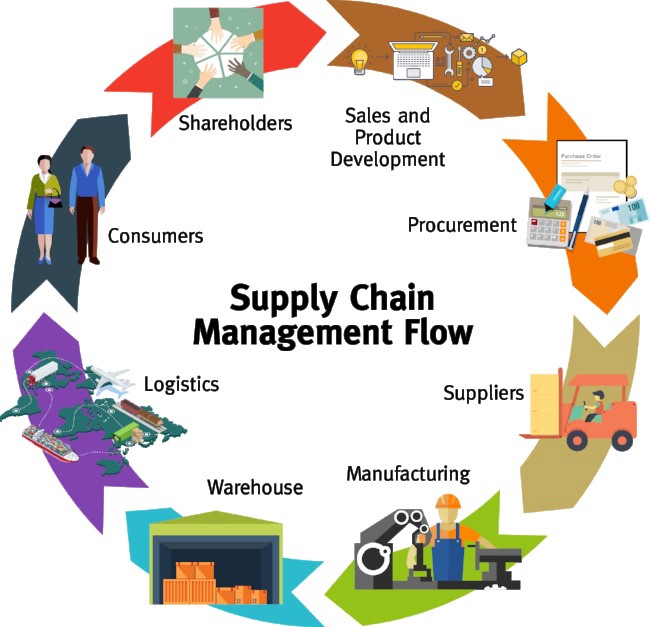Know About SCM
Supply Chain Management
Supply chain management is the control of the flow of goods and services, and it encompasses all processes that turn raw materials into completed goods. In order to maximize customer value and gain a competitive edge in the market, it involves the purposeful simplification of a company’s supply-side processes.
How Supply Chain Management Works?
Through supply chain management, suppliers try to create and run supply chains that are as efficient and cost-effective as is practical (SCM). Supply chains cover all aspects of production, product development, and the information systems required to coordinate these processes.
SCM frequently seeks to centrally link or manage the production, shipping, and distribution of a product. By streamlining the supply chain, businesses can reduce wasteful spending and speed up the delivery of items to customers. To do this, a tight eye is kept on internal stocks, internal production, internal distribution, internal sales, and the inventory of firm vendors.
The idea that practically all sold products are the result of the labour of several businesses connected by a supply chain is the basis of SCM. Supply chains have been around for a very long time, but most companies have only recently realised the value they can provide to their operations.
5 Elements of SCM
The supply chain manager works to cut back on shortages and keep costs in check. More than merely placing orders for goods and handling logistics are part of the job. To increase productivity and lower costs associated with an organization’s supply chain, supply chain managers supervise and manage the whole supply chain as well as logistical activities.
The bottom line of a business can be immediately impacted by gains in productivity and efficiency. Businesses avoid costly recalls and legal lawsuits and stay out of the limelight thanks to effective supply chain management. Supply chain management coordinates the logistics for all areas of the supply chain, which consists of the following five elements (SCM).
Planning
To get the best results, SCM frequently begins with planning to match supply with customer and manufacturing demands. Future customer expectations must be anticipated, and suitable action must be taken. This has to do with the raw materials needed for each manufacturing stage, the equipment’s capabilities and limitations, and the manpower requirements for the SCM process. Large firms commonly use the components of ERP systems to gather information and formulate plans.
Sourcing
SCM processes that are effective strongly rely on positive supplier relationships. Sourcing is the process of working with vendors to obtain the raw materials needed for the manufacturing process. A business may be able to plan and work with a supplier to receive things in advance. However, sourcing requirements may change based on the sector. In general, SCM sourcing includes ensuring:
- The raw materials are in compliance with the requirements for manufacturing the goods.
- The prices paid are consistent with what the market would anticipate.
- In the event of unforeseeable catastrophes, the vendor has the flexibility to send emergency supplies.
- The supplier has a track record of providing goods that are both timely and of high quality.
Supply chain management is crucial for producers working with perishable goods. When sourcing products, businesses should take lead times and a supplier’s capacity to meet needs into account.
Manufacturing
At the heart of the supply chain management process is the corporation’s conversion of raw materials into something new employing machinery, personnel, or other external elements. This final product is what the manufacturing process eventually seeks to generate, even if it is not the last stage in the supply chain management process.
The manufacturing process can be further divided into sub-processes like assembling, testing, inspection, or packaging. A business needs to be aware of waste and other manageable problems that may arise during the manufacturing process and affect what was originally intended. For instance, if a company discovers that it is using more raw materials than it had planned and sourced, it must fix the issue or return to the SCM’s beginning phases.
Delivering
After production and closing sales, a company must deliver its products to clients. The distribution method is frequently seen as a contributor to the brand’s reputation even though the customer has not yet interacted with the products. A company with efficient SCM procedures has strong delivery channels and logistical capabilities to ensure the prompt, safe, and inexpensive delivery of goods.
Additionally, in the event that one form of transportation is briefly rendered inoperable, other or diverse distribution techniques must be in place. How may record snowfall in the vicinity of distribution centers impact a company’s delivery process, for instance?
Returning
The process of supply chain management comes to a finish with customer returns and product support. Even worse is when a customer returns a product because the company made a mistake. The business must confirm that it has the tools necessary to receive returned goods and correctly distribute refunds for them. Reverse logistics is a common name for this return process. Whether a corporation is conducting a product recall or a customer is simply displeased with the products, the commercial transaction with the client needs to be settled.
Many individuals consider consumer returns to be a form of customer–business dialogue. However, a key element of customer returns is the intercompany communication to identify faulty goods, expired goods, or non-conforming items. If the primary cause of a customer return is not addressed, subsequent returns are likely to persist, and supply chain management will have failed.

